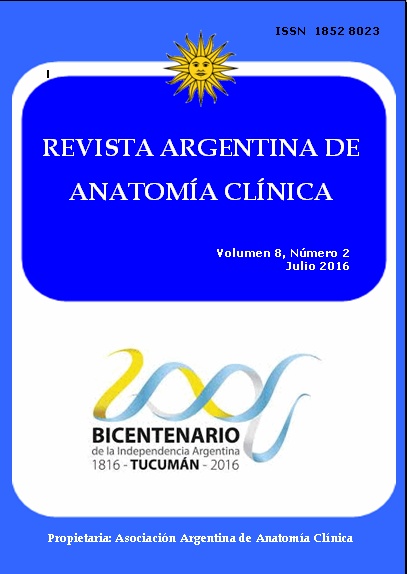MORPHOMETRIC PARAMETERS OF THE GLENOID FOSSA WITH THE LABRUM ATTACHED. Parámetros morfométricos de la fosa glenoidea con el labrum incluido
DOI:
https://doi.org/10.31051/1852.8023.v8.n2.14428Palabras clave:
Glenoid fossa height, Glenoid fossa width, Scapula, Altura de la cavidad glenoidea, Anchura de la cavidad glenoidea, Escápula.Resumen
Background: The height and width of the glenoid fossa is important in total shoulder replacement. Previous studies, using different methods, have reported differences in glenoid fossa height and width. The current study aims to provide the morphometric parameters of the glenoid fossa with the labrum attached. Material and Methods: One hundred and forty shoulders from 30 males and 40 females were dissected and measurements taken. Exposure of the glenoid fossa with the labrum attached was undertaken, followed by direct measurement of glenoid height, width and level of maximum width using digital calipers. Data were double-entered into the Statistical Package for Social Sciences (SPSS, version 21). Kruskal-Wallis and One Way Analysis of Variance on Ranks tests were used. Statistical significance was defined as p<0.05. Results: The overall mean height, width and the level of maximum width for both genders were 38.94 mm, 30.50 mm and 17.14 mm respectively. However, the mean height, width and level of maximum width were significantly greater in males than females (P<0.001 for each). Conclusion: The mean height, width and the level of maximum width with the glenoid labrum attached were significantly greater in males than females. It suggests that the increase in height and width is due to the glenoid labrum is proportionate to the height and width of the glenoid fossa thus accounting for the difference between males and females remaining significant with or without the glenoid labrum.
Introducción: La altura y la anchura de la cavidad glenoidea es importante en el reemplazo total de hombro. Estudios previos, utilizando diferentes métodos, han presentado diferencias respecto a la altura y a la anchura de la cavidad glenoidea. El presente estudio tiene como objetivo proporcionar los parámetros morfométricos de la fosa glenoidea con el labrum incluido. Materiales y métodos: Se disecaron y tomaron medidas de ciento cuarenta hombros pertenecientes a 30 varones y 40 mujeres. La cavidad glenoidea se expuso con el labrum incluido y seguido de la medición directa de la altura de la cavidad glenoidea, la anchura y el nivel de máxima anchura usando calibres digitales. Los datos tuvieron doble entrada en el Paquete Estadístico para Ciencias Sociales (SPSS, versión 21). Se utilizaron Kruskal - Wallis y análisis de varianza de una sola vía en las pruebas de filas. La significancia estadística se definió como p<0,05. Resultados: Los valores de la altura, anchura y altura a la anchura máxima media para ambos sexos fueron: 38,94 mm, 30,50 mm y 17,14 mm, respectivamente. Sin embargo, la altura media, anchura y nivel de anchura máxima fueron significativamente mayores en los hombres que en las mujeres (p< 0,001 para cada uno). Conclusiones: La altura media, anchura y el nivel de máxima anchura con el labrum glenoideo incluido fueron significativamente mayores en hombres que en mujeres. Esto sugiere que el aumento de la altura y la anchura se debe a que el labrum glenoideo es proporcional a la altura y la anchura de la cavidad glenoidea, teniendo en cuenta la diferencia de los resultados tomados entre varones y mujeres, con o sin el labrum glenoideo incluido.
Referencias
Bicknell RT, Patterson SD, King GJW, Chess DG, Johnson JA. 2007. Glenoid vault endosteal dimensions: An anthropometric study with special interest in implant design Journal of Shoulder and Elbow Surgery 16: 97-101.
Checroun AJ, Hawkins C, Kummer FJ, Zuckerman JD. 2002. Fit of current glenoid component designs: An anatomic cadaver study. Journal of Shoulder and Elbow Surgery 11: 614-617.
Codsi MJ, Bennets C, Gordiev K, Boeck DM, Kwan Y, Brems J, Powell K, Ianotti JP. 2008. Normal glenoid vault anatomy and validation of a novel glenoid implant shape. Journal of Shoulder and Elbow Surgery 17: 471-478.
Churchill RS, Brems JJ, Kotschi H. 2001. Glenoid size, inclination, and version: an anatomic study. Journal of Shoulder and Elbow Surgery 10: 327-332.
De Wilde LF, Berghs BM, Audenaert E, Sys G, Van Maele, Barbaix E. 2004. About the variability of the shape of the glenoid cavity. Surgical and Radiologic Anatomy 26:54-59.
Iannotti JP, Gabriel JP, Schneck SL, Evans BG, Misra S. 1992. The normal glenohumeral relationships. Journal of Bone and Joint Surgery 74-A:491-500.
Kwon YW, Powell KA, Yum JK, Brems JJ, Ianotti JP. 2005. Use of three – dimensional computed tomography for the analysis of the glenoid anatomy. Journal of Shoulder and Elbow Surgery 14: 85-90.
Mallon WJ, Brown HR, Vogler JB, Martinez S. 1992. Radiographic and geometric anatomy of the scapula. Radiographic Scapular Anatomy 277:142-154.
Merrill A, Guzman K, Miller SL. 2009. Gender differences in glenoid anatomy: an anatomic study. Surgical and Radiologic Anatomy 31:183-189.
Descargas
Publicado
Número
Sección
Licencia
Los autores/as conservarán sus derechos de autor y garantizarán a la revista el derecho de primera publicación de su obra, el cuál estará simultáneamente sujeto a la Licencia de reconocimiento de Creative Commons que permite a terceros compartir la obra siempre que se indique su autor y su primera publicación en esta revista. Su utilización estará restringida a fines no comerciales.
Una vez aceptado el manuscrito para publicación, los autores deberán firmar la cesión de los derechos de impresión a la Asociación Argentina de Anatomía Clínica, a fin de poder editar, publicar y dar la mayor difusión al texto de la contribución.



